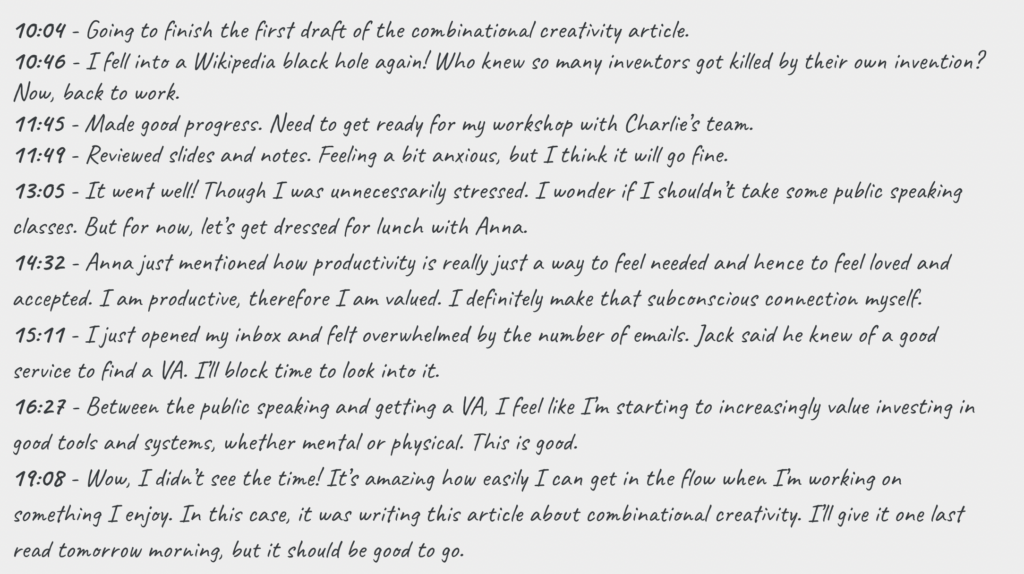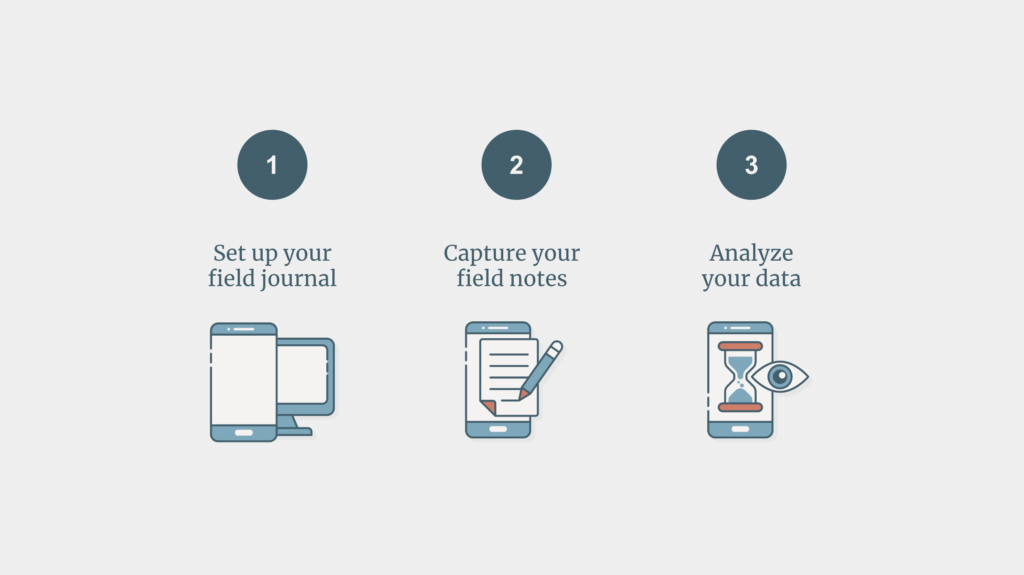When was the last time you stopped to truly observe your own life? Turning an anthropological lens on yourself might feel strange, but it can lead to invaluable insights, allowing you to uncover patterns, gain self-knowledge, and imagine new possibilities.
Anthropologists ask fundamental questions such as: What does it mean to live in our world as a human being? How can the study of humanity reveal new ways of being human and help us imagine our collective future?
It’s a game of curiosity and patience, an exercise in humility and receptiveness. And it’s a game you can play to learn more about yourself and where you stand in the world. You simply need to turn into an anthropologist where the topic of study is your own life.
In search of answers, anthropologists conduct fieldwork: they go into the field and write field notes. These notes could be written accounts of observations, or they may take the form of visual maps to chart relationships and uncover intriguing paths.
In the same way that anthropologists take field notes to understand humanity, you can use this practice to learn more about who you are and how to improve your life. Keeping a personal field journal will allow you to create a trail of breadcrumbs to deconstruct patterns and imagine new directions. Let’s see how it works.
The power of personal field notes
I was first introduced to the idea of adding timestamps to my notes by Tony Stubblebine, the CEO of Medium, who notes the time and writes a few sentences in a journal every time he switches work projects. Because he journals in the interstice between projects, Stubblebine dubbed this practice interstitial journaling.
Then, I started seeing such timestamped notes everywhere. Timestamped notes are ubiquitous in professions where important decisions must be made based on rapidly changing information. Doctors write patient charts, pilots keep flight logs, scientists track their research in lab notebooks, system engineers record events to the syslog, journalists have interview transcripts, and project managers often maintain work logs.
Inspired by all these forms of timestamped notes, personal field notes offer a hybrid of journaling and note-taking specifically designed to audit your daily experiences. The basic idea is to write a few lines every time you take a break and track the exact time you take these notes. It looks like this:

(this example is all neatly spelled out, but your notes will be much messier, using shorthand and abbreviations so you can quickly capture ideas on the go)
Unlike logs that focus on events at work or interstitial journaling, which is confined to workday transitions, personal field notes can be captured anytime and anywhere – whether at the office, home, commuting, or even mid-conversation when something piques your interest. (My friends sometimes make fun of me when I grab my phone saying “Wait, I need to write that down!” while we chat – it usually means it’s a good chat).
Field notes are powerful for several reasons. By encouraging you to capture your thoughts while listening to podcasts, reading articles, or even during conversations, they help you become a more active observer of your own life. They take very little time; a few seconds whenever you observe something interesting. And because they are timestamped, they help make it easier to identify under what conditions you work, learn, and feel best.
By taking notes in the present moment instead of waiting until a dedicated time to reflect, you are less likely to forget some important experiences; this includes fleeting moments of inspiration and ideas that often get lost in the bustle of the day.
And when you collect lots of small data points, you create a “breadcrumbs trail” and are more likely to notice overarching trends than if you only focus on the most salient experiences. By recording your activities, thoughts, and emotions, these notes will serve as a rich source of observations you can then turn into insights to guide your next growth loop.
How to practice self-anthropology
Practicing self-anthropology with field notes only takes three steps. This exercise in self-exploration requires no special skills but the willingness to slow down and take notes throughout the day.
You will, however, need to approach this practice with the same receptive and inquisitive attitude of an anthropologist studying an unfamiliar culture. With a little curiosity and patience, your own fieldwork will reveal inspiration to create positive change.
Let’s go over the steps to turning an anthropological lens on yourself:

Step 1: Set up your field journal
First, you need a simple, low-friction way to take notes. Where do you take quick notes when you’re in a rush? This is where your field notes should go. It could be in your phone or a notebook – wherever it feels most comfortable. Seriously, don’t overthink it: you can use Asana, Evernote, or any other notetaking app. Apple Notes or Google Keep is fine!
Create a note on your phone or start a new page in your notebook. This will be your field journal (mine is synced between my phone and my laptop, so I have access to it on the go and I can open it in a tab when working).
Step 2: Capture your field notes
You need enough data to start noticing patterns, so aim to capture field notes for at least 24 hours. When feeling particularly lost, I do intense personal fieldwork for three to five days.
Choose a day in the next week when you will start this exercise. Ideally, it should be a typical day with a mix of professional and personal activities. Don’t do it on your best friend’s wedding day or when management is due to announce the latest round of promotions.
Keep your field journal with you (that’s why a note on your phone works great). Write the time and a couple of sentences whenever you take a break, switch tasks, or notice something interesting. That “something interesting” could be external such as an event, or internal such as a feeling – maybe uneasiness or excitement. If something made you stop for a second to wonder whether you should write it down, then it’s interesting enough.
Embrace non-linearity: You have complete freedom to write in a stream-of-consciousness style to capture and connect your observations as they arise. Interactions, emotions, moments of curiosity, emerging interests… Did someone compliment you? Were you excited by a particular announcement? Were you faced with a surprising challenge? Did you find a piece of work particularly draining or stimulating? There are no limitations as to what you can include in your field notes, but here are some ideas to inspire you:
- Insights: Your moments of curiosity, random thoughts, new ideas, and questions that spark your interest.
- Encounters: Your social interactions or new connections made and any insights or feelings that arose from them.
- Mood: Your emotions during or after an experience, whether a meeting, a workout, a podcast, etc.
- Energy: Your shifts in energy levels throughout the day, as well as what gives you energy or drains your energy.
- Other: Anything else that doesn’t fit in the previous categories.
It may seem like a lot, but remember that this is only for a few days at most. You are doing deep field work and want to ensure you don’t miss anything. Use your curiosity as a compass to decide what to write down.
Step 3: Analyze your data
After 24 hours (or a bit longer), you will have a treasure trove of field notes. It’s time to review them. If your field notes are on paper, you may want to grab some colored pens. If you captured them digitally, it can be easier to copy and paste them into a document to highlight and move text around.
Spend time reading your notes and reflecting on the experiences you’ve documented. Look for recurring themes, interesting details, and general feelings that come up repeatedly.
This is a very fluid process. You may want to create a category for “things that give me joy” and “things that drain me”, or “what I want more of” and “what I want less of”, or create big categories for important aspects of your life like learning, relationships, and health.
Simply by grouping your breadcrumbs into larger piles, you will start to see some patterns emerge. Identify an observation that stands out to you. This could be a recurring theme, a persistent challenge, or a point of curiosity. For instance, you could notice that you have the “morning blues” every day when it’s time to go to work, that working on a specific type of task drains your energy, or that your moods tend to be higher when you work on group projects.
You can then turn your observation into an actionable question. For example, if your observation is that you’re feeling energized when discussing certain topics, you might ask: “How can I incorporate more of this into my daily life?” This can be the seed of a little life experiment – something new you want to try to see if it improves your creativity, productivity, and wellbeing.
And if you enjoyed the few days of taking field notes, you don’t have to stop! I personally take them all the time, albeit in a less intense way than I do when I’m feeling lost and need to recalibrate.
Practicing self-anthropology opens up new possibilities. Taking field notes is like planting the seeds of insights that will eventually grow into greater self-knowledge. Equipped with a fresh perspective, you can rethink habits, relationships, and priorities. So create a new note, grab your journal, and explore the uncharted territory of your own life with an open mind; you never know what you could find.
